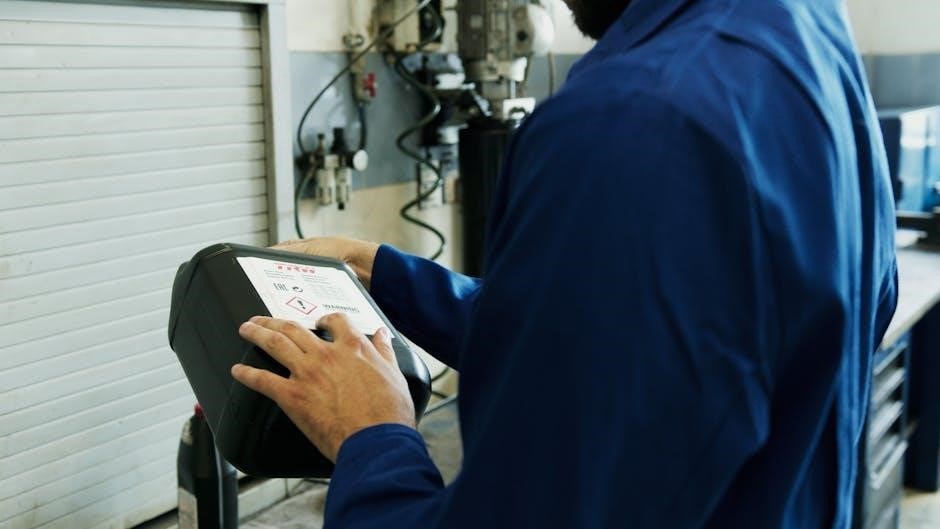A manual check is a payment method bypassing automated systems, typically for immediate or one-time payments, involving human intervention to ensure accuracy and address unique scenarios.
Definition of Manual Checks
A manual check is a payment method prepared outside automated systems, typically for immediate or one-time needs. It involves human intervention to verify, validate, or inspect tasks, data, or systems, ensuring accuracy and compliance with standards. Unlike automated checks, manual checks require physical or visual examination and deliberate entry into financial records. They are often used for unique scenarios, such as lost checks, system errors, or urgent payments, where automated processes cannot be applied.
Purpose of Manual Checks
Manual checks serve as a reliable fallback for situations requiring immediate or unique payment solutions. They are essential for addressing emergencies, correcting errors, or handling one-time transactions that automated systems cannot process. Their purpose also includes ensuring compliance with financial regulations and providing a means to resolve payment discrepancies. By allowing for direct intervention, manual checks offer flexibility and accuracy, making them indispensable in specific financial scenarios where automation alone is insufficient.

Types of Manual Checks
Manual checks are categorized based on payment needs, such as one-time, replacement, or emergency payments, each serving distinct financial or situational requirements.
One-Time Payment Checks
One-time payment checks are issued for non-recurring payments, such as freelance work, special requests, or unique transactions. They are not part of regular payment cycles and are often used for unexpected expenses or one-off services. These checks are typically processed separately from standard payments, requiring specific approval and documentation to ensure accuracy. They provide flexibility for organizations to address ad-hoc financial obligations without disrupting their routine payment systems.
Replacement Checks
Replacement checks are issued when a check is lost, stolen, or damaged. They serve as substitutes for the original payment, ensuring the recipient receives the intended funds. These checks are typically marked as “void” or “replacement” to avoid confusion. The process involves canceling the original check, verifying the recipient’s details, and issuing a new one with updated security features. Proper documentation and approval are essential to prevent fraud and ensure the replacement check is legitimate and accurately processed.
Emergency Payments
Emergency payments are manual checks issued to address urgent or unforeseen financial needs. They are often used for critical situations, such as immediate vendor payments, employee salary advances, or essential service payments. These checks bypass standard processing timelines, ensuring rapid disbursement. Proper documentation and approval are required to maintain accountability and prevent misuse. Emergency payments highlight the flexibility of manual checks in resolving time-sensitive financial matters efficiently.
Off-Cycle Payments
Off-cycle payments are manual checks issued outside the standard payment schedule, addressing urgent or unexpected financial needs. They are typically used for immediate payments that cannot wait for the next regular pay period. Common scenarios include employee salary advances, emergency vendor payments, or essential service disbursements. These payments require special documentation and approvals to ensure legitimacy and accountability. Off-cycle payments highlight the adaptability of manual checks in managing unforeseen financial situations that fall outside the usual payment cycle.

Process of Issuing Manual Checks
The process involves preparing and approving checks, ensuring accuracy and compliance. Checks are printed, signed, distributed, and recorded in financial systems for accountability and tracking purposes.
Preparation and Approval
Preparation involves creating check details, verifying payee information, and ensuring the amount and date are accurate. Approval requires reviewing the request, confirming funds availability, and ensuring compliance with policies. Proper authorization is essential to prevent errors or fraud. This step ensures accountability and maintains financial integrity.
Issuance and Distribution
Issuance involves printing or handwriting the check, ensuring all details like date, payee name, and amount are correct. Distribution includes delivering the check to the recipient, either in person, by mail, or through a secure service. Proper tracking and documentation are essential to confirm delivery. A receipt or acknowledgment may be requested to verify the payee has received the check, ensuring accountability and security in the payment process.
Recording in Financial Systems
Recording manual checks in financial systems is crucial for transparency and compliance. After issuance, details such as check number, date, payee, and amount are entered into accounting software. This ensures accurate financial records and proper reconciliation. The check is also logged in the general ledger, with debits and credits reflecting the transaction. Maintaining an audit trail helps track payments and verify legitimacy. This step ensures accountability and supports financial reporting, making it easier to monitor expenditures and comply with financial regulations.

Scenarios for Manual Checks
Manual checks are used in situations like lost or missing checks, system errors, immediate payment needs, or final paychecks for terminated employees to ensure timely payments.
Lost or Missing Checks
Lost or missing checks are a common scenario requiring manual checks. When a check is misplaced or never received, a manual check ensures the payee receives payment. Organizations typically stop payment on the lost check and issue a replacement. Verification steps are taken to confirm the check’s status and prevent fraud. This process helps maintain trust and financial integrity, ensuring timely payments even when discrepancies arise.
System Errors or Failures
System errors or failures often necessitate the use of manual checks as a fallback solution. When automated payment systems malfunction or encounter technical issues, manual checks ensure payments are processed on time. This is particularly crucial for payroll or urgent payments, where delays could cause operational disruptions; The finance team intervenes by issuing manual checks after verifying payment details, ensuring continuity and preventing financial discrepancies.
Immediate Payment Needs
Manual checks are often used to address immediate payment needs when timely processing is critical. Situations like emergency payments, urgent vendor payments, or last-minute payroll adjustments require swift action. Automated systems may not accommodate these sudden requirements, making manual checks a reliable solution. They ensure payments are issued quickly, preventing delays that could lead to penalties or operational disruptions. This flexibility is essential for maintaining financial stability in time-sensitive scenarios.
Final Paychecks for Terminated Employees
Manual checks are commonly used to issue final paychecks for terminated employees. This ensures timely payment of accrued wages, benefits, or unused leave. Companies often opt for manual checks to meet legal deadlines for final payments, avoiding potential penalties. Additionally, manual checks provide a secure method to deliver payment to employees who may no longer have access to direct deposit. This approach ensures compliance with labor laws and maintains a smooth transition for departing employees.

Advantages of Manual Checks
Manual checks provide flexibility, accuracy, and compliance, ensuring timely and secure payments, reducing errors, and maintaining control over transactions while adhering to specific regulations and requirements.
Flexibility in Payments
Manual checks offer flexibility in payments by allowing organizations to issue payments outside regular cycles or automated processes. They accommodate unique payment needs, such as one-time payments, emergency disbursements, or off-cycle payments. This flexibility is particularly useful for addressing unexpected expenses or specific requests from payees. Manual checks also enable adjustments to payment details, like payee information or amounts, after issuance, providing greater control over financial transactions and ensuring payments align with varying circumstances or requirements.
Accuracy in Transactions
Manual checks ensure accuracy in transactions by involving thorough preparation and review processes. Each check is carefully examined to prevent errors, such as incorrect amounts or payee details. Multiple approval steps add another layer of verification, reducing the likelihood of mistakes. This attention to detail ensures precise payments that meet financial standards, maintaining trust and integrity in transactions.
Compliance with Regulations
Manual checks ensure adherence to legal and financial standards, reducing risks of non-compliance. They often involve detailed documentation, which aids in audits and demonstrates regulatory conformity. By following established protocols, manual checks help organizations meet specific industry requirements and legal obligations. This is particularly important for tax compliance, where accurate reporting is crucial; The structured process minimizes deviations from regulatory guidelines, ensuring all payments align with applicable laws and standards.
Challenges of Manual Checks
Manual checks are time-consuming, prone to human error, and increase administrative workload, requiring significant financial and staff resources, making them less efficient than automated systems.
Time-Consuming Process
Manual checks involve multiple steps, including preparation, approval, and issuance, which can significantly delay payment processing. Each check requires individual verification, increasing the overall time required compared to automated systems. This slower process can lead to late payments, affecting vendor or employee relationships. Additionally, manual checks often involve manual data entry, which is not only time-consuming but also prone to errors. The need for physical distribution further extends the timeline, making manual checks less efficient than digital alternatives.
Prone to Human Error
Manual checks are highly susceptible to human error due to the involvement of manual data entry, calculation, and document handling. Errors can occur in payment amounts, recipient details, or authorization steps, leading to financial discrepancies or delayed payments. Additionally, manual checks lack the automation that minimizes mistakes, making them more error-prone compared to digital systems. These errors can result in financial losses, legal issues, or strained relationships with vendors or employees, emphasizing the need for rigorous verification processes.
Higher Administrative Burden
Manual checks significantly increase the administrative workload due to the time and effort required for preparation, approval, and issuance. Unlike automated processes, manual checks involve multiple steps, such as data entry, verification, and physical handling, which consume more staff hours. This leads to higher labor costs and the need for additional personnel to manage the process. Furthermore, manual checks require extensive documentation and storage, adding to the overall administrative complexity and resource allocation.

Best Practices for Manual Checks
Adopt standardized procedures, ensure secure storage, and regularly train staff to minimize errors and enhance efficiency in manual check processes;
Documentation and Record-Keeping
Accurate documentation is crucial for manual checks to ensure transparency and accountability. Maintain detailed records of check issuance, including dates, amounts, payee information, and purpose. Securely store physical and digital copies to prevent loss or tampering. Proper documentation aids in audit trails, financial reconciliation, and compliance with regulations. It also helps track payments, verify legitimacy, and reduce discrepancies, ensuring smooth financial management and adherence to organizational policies.
Verification Before Issuance
Verifying manual checks before issuance is essential to ensure accuracy and prevent errors. Review payee details, amounts, and approval signatures to confirm legitimacy. Cross-check with financial records and ensure compliance with organizational policies. This step minimizes fraud risks and ensures payments are authorized. Verification also helps detect discrepancies early, reducing the likelihood of financial losses. It fosters accountability and maintains the integrity of the payment process, aligning with regulatory requirements and organizational standards.
Training for Staff
Proper training for staff is crucial to ensure the efficient and accurate issuance of manual checks. Employees should receive comprehensive training on procedures, policies, and compliance requirements. Regular updates on new regulations and best practices help maintain consistency. Hands-on training sessions and workshops can improve understanding and reduce errors. Well-trained staff are better equipped to handle complex scenarios, ensuring smooth operations and minimizing discrepancies. Ongoing training fosters confidence and competence, leading to improved overall performance in managing manual checks effectively.

Manual Checks in Payroll Processing
Manual checks in payroll processing are issued for missed pay periods, terminations, or corrections. They ensure accurate payment distribution, adhering to labor laws and employee agreements.
Calculation and Issuance
Manual checks in payroll processing involve the calculation of exact payment amounts, including gross pay, deductions, and tax withholdings, ensuring compliance with labor laws. The issuance process requires preparing checks with accurate payee details, dates, and amounts. Distribution methods are secure to prevent fraud or loss. The process is meticulous, with thorough reviews and approvals to ensure precision and prevent errors. This step is crucial for maintaining accurate financial records, ensuring timely payments, and upholding employee trust in the payroll process.
Handling Missed Payments
Manual checks are often used to address missed payments, ensuring employees receive their rightful compensation. Payroll teams identify discrepancies in payment schedules and issue manual checks to cover unpaid amounts. This process involves verifying payment details, obtaining approvals, and generating replacement checks promptly. Accurate documentation is essential to maintain financial records and compliance. Handling missed payments with manual checks ensures timely resolution and maintains employee trust in the payroll system. Regular audits help prevent recurring issues.
Ensuring Compliance with Labor Laws
Manual checks are essential for ensuring compliance with labor laws, particularly in payroll processing. They allow employers to issue payments that align with legal requirements, such as minimum wage and timely payment regulations. Manual checks are often used for final paychecks, ensuring terminated employees receive all due wages. Employers must adhere to labor laws when issuing manual checks, including providing detailed breakdowns of deductions and ensuring payments are made within legal timeframes. Proper documentation is critical to demonstrate compliance.

Manual Checks in Accounting
Manual checks in accounting ensure financial record accuracy by verifying each transaction’s legitimacy and completeness, crucial for reconciliation and maintaining a clear audit trail for compliance.
Financial Record Accuracy
Manual checks play a crucial role in maintaining financial record accuracy by ensuring all transactions are verified before being recorded. In accounting, manual checks involve reviewing each transaction for correctness, completeness, and compliance with accounting standards. This step prevents errors, such as incorrect amounts or misposted entries, from being reflected in financial statements. By manually verifying data, organizations can maintain reliable records, ensuring accurate reporting and compliance with regulatory requirements. This process is essential for trustworthy financial data and decision-making.
Reconciliation Processes
Reconciliation processes involve verifying the accuracy of financial records by comparing internal accounts with external statements. Manual checks play a crucial role in this process, ensuring that all transactions are accounted for and discrepancies are identified. By reviewing bank statements, invoices, and payment records, manual checks help maintain the integrity of financial data. This step is essential for detecting errors, fraud, or mismatches, ensuring that the organization’s finances are accurate and up-to-date. Proper documentation and audit trails support this process.
Audit Trail Maintenance
Manual checks play a crucial role in maintaining an audit trail, ensuring transparency and accountability. An audit trail involves documenting every step of a manual check’s lifecycle, from preparation to issuance and distribution. This includes recording dates, amounts, payee details, and approval signatures. Proper audit trails help organizations comply with financial regulations and withstand audits. They also enable the identification of errors or fraud by providing a clear, traceable record of all transactions. Accurate and detailed documentation is essential for maintaining integrity in financial processes.

Manual Checks in Quality Assurance
In quality assurance, manual checks refer to systematic inspections and verifications to ensure products meet specified standards and requirements.
- Involve physical inspections of products to identify defects or deviations.
- Include design verification to confirm adherence to specifications and regulations.
- Ensure compliance with quality standards, enhancing customer satisfaction and reliability.
- Access Control: Verifying credentials before granting entry to secure areas.
- Surveillance: Monitoring activities to identify suspicious behavior.
- Emergency Response: Conducting manual sweeps to ensure safety during crises.
Product Inspection
Manual checks in product inspection involve physically examining goods to ensure they meet quality and safety standards. This process includes visual assessments, testing, and verifying specifications. By identifying defects or inconsistencies, manual checks help prevent faulty products from reaching consumers. Documentation of findings is crucial for traceability and addressing issues. Regular product inspections maintain customer trust and brand reputation, ensuring compliance with industry regulations and reducing liability risks.
Design Verification
Design verification involves manual checks to ensure that a design meets specified requirements and standards. This process includes reviewing blueprints, schematics, and prototypes to confirm functionality and compliance. Manual checks are essential for identifying potential flaws or deviations early in the development phase. Experts conduct thorough inspections, simulations, and testing to validate design integrity. This step is critical for maintaining quality, safety, and performance standards in various industries, from engineering to product development.
Compliance with Standards
Manual checks in quality assurance ensure products meet predefined standards by conducting thorough inspections and tests. These checks verify design specifications, functionality, and safety requirements. By manually reviewing each component, teams can identify deviations and correct them before final approval. Compliance with industry standards is maintained through detailed documentation and consistent testing protocols. This process ensures reliability and consistency, adhering to regulatory and customer expectations. Manual checks provide a final layer of assurance, safeguarding quality and minimizing risks.

Manual Checks in Security Contexts
Manual checks in security contexts involve physical inspections, identity verification, and surveillance to ensure safety and compliance. They are critical for preventing unauthorized access and detecting threats.
These checks complement automated systems, ensuring robust security protocols.
Physical Security Checks
Physical security checks involve manual inspections to ensure the safety and integrity of a location or asset. These checks are conducted by security personnel to identify potential vulnerabilities or threats. They include visual inspections of premises, verification of access controls, and monitoring of surveillance systems. Physical checks are essential in high-security environments like airports, government buildings, and sensitive facilities. They help prevent unauthorized access, detect suspicious activities, and maintain overall security protocols. Regular manual checks complement technological security measures, ensuring a robust security framework.
Aviation Security Screening
Aviation security screening involves manual checks to ensure the safety of passengers, crew, and aircraft. These checks include physical inspections of luggage, pat-downs of individuals, and verification of identification documents. Security personnel use their judgment to detect potential threats, such as prohibited items or suspicious behavior. Manual checks are crucial in aviation as they provide an additional layer of security beyond automated systems, helping to prevent unauthorized items from boarding flights and ensuring compliance with aviation regulations.
Border Control Inspections
Manual checks in border control inspections involve the thorough examination of individuals, luggage, and documents to ensure compliance with immigration, customs, and security regulations. These checks are essential for verifying identities, detecting prohibited items, and preventing illegal activities. Border officials conduct manual inspections when automated systems flag anomalies or when additional scrutiny is required. This process ensures the accuracy of information and the safety of individuals, making it a critical component of national security protocols.
Manual checks in this context often involve human judgment, as officers assess the legitimacy of travel documents, question travelers, and inspect belongings. This hands-on approach allows for a detailed review that automated systems may miss. By maintaining a balance between technology and manual oversight, border control agencies can effectively manage risks and uphold legal standards while facilitating smooth travel processes.
Manual checks remain essential for addressing unique payment scenarios, ensuring accuracy, and maintaining compliance across various industries, despite their administrative demands and susceptibility to errors.
Manual checks are essential for ensuring accuracy and reliability in various processes. They involve human verification to detect errors or inconsistencies, playing a crucial role in payment processing, payroll, and security. Manual checks provide flexibility, compliance, and precision but can be time-consuming and prone to human error. Best practices include thorough documentation, verification, and staff training to mitigate challenges. Despite advancements in automation, manual checks remain vital for addressing unique scenarios and ensuring operational integrity across industries.
Future of Manual Checks
As technology advances, manual checks may gradually be replaced by automated systems, but they will remain essential for specific scenarios requiring human intervention. The future likely involves a hybrid approach, blending automation with manual oversight for critical or exceptional cases. Enhanced security measures and compliance standards will continue to shape their use, ensuring accuracy and adherence to regulations. Despite technological advancements, manual checks will retain their importance in handling unique or high-stakes financial transactions.